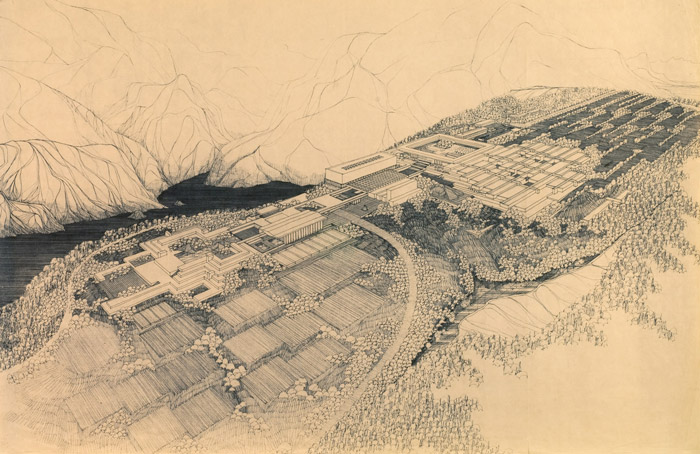Since the middle of the 20th century, Arthur Erickson’s buildings have modified Canada’s physical, cultural, and architectural landscape. Université du Quebec a Montréal’s (UQAM) Centre du Design is currently bringing his work to light in Arthur Erickson: Lignes topographiques / Sight Lines, a showcase of previously unseen sketches that would eventually become some of his most well-known projects.
Erickson, born in Vancouver in 1924, studied architecture before travelling to Montreal to attend McGill’s School of Architecture. There, he conceived of and eventually built many seminal buildings that would change the faces of cities across Canada.
The exhibition space at the Centre du Design is a humble room, but the tall ceilings and modern concrete floor create a sense of spaciousness that aligns beautifully with the grace of Erickson’s sketches. Part One of the exhibit features sketches of eight private and commercial endeavours across Canada. Some of these projects were never realized, but those that were constructed are accompanied by a photo series taken by photographer and McGill architecture professor, Ricardo L Castro. Particularly striking are the sketches for Simon Fraser University, where the darker tones and dramatic depth of field bring the image to life.
Each of the eight projects have three to four sketches displayed. The drawings—which in some cases are torn, folded, or stained—look almost like discovered objects instead of architectural plans. Rather than give the content an unprofessional air, however, the roughness of some of the sketches offers a more immediate connection to Erickson’s creative process. While some are drawn painstakingly with ruler and thin graphite, others are in a style similar to blind contour. Either way, it’s easy to imagine these sketches as treasures just waiting to be discovered amongst piles of architectural ephemera.
The sketches appear to be more a relic of art than a study in structural engineering. They serve as a reminder of the artistic nature of architecture in general. By placing the photos side by side with the sketch, the curators remind the viewer that the manipulation of line, space, shape, and shadow is often applied to the building as it is in the drawing.
It can be difficult to appreciate the grandeur of architecture through 2D sketches. The exhibit attempts to create a sense of scale by filling one blank wall with projected colour photos of the projects, which is a refreshing change from the many grayscale sketches. Without the accompanying photography the exhibit would be somewhat dry and hard to digest; the photos are a refreshing reminder of the architecture’s real world significance.
The second part of the exhibit displays sketches that were done while Erickson was a student at McGill in the late ‘40s. These sketches are showcased flat on a long table, allowing for a more intimate examination of the drawings. This collection also includes reproductions from McGill’s Canadian Architecture Collection and the University of Calgary’s Canadian Architectural Archives. The reproductions flesh out the exhibition overall but don’t compare to the intimacy of the original sketches.
There is architecture everywhere, but it’s easy to overlook the detail and care that goes into planning a building. In fact, the product of an architectural project goes on to be more than a building—it’s an important cultural and historical marker that will remain for generations to see and experience. In this way architecture may be the most influential field of art, engineering, and design. Exhibitions like this do a great service to the field and to the public by highlighting the importance and beauty of architecture, including the sketches that launch these projects into reality.
Arthur Erickson: Lignes topographiques / Sight Lines will be on display at the Université du Quebec a Montréal’s (UQAM) Centre du Design (1440 Sanguinet) until Oct. 18. Admission is free.









Pingback: Museum & Gallery Listings for Oct. 2-8 - ELLC Properties Management